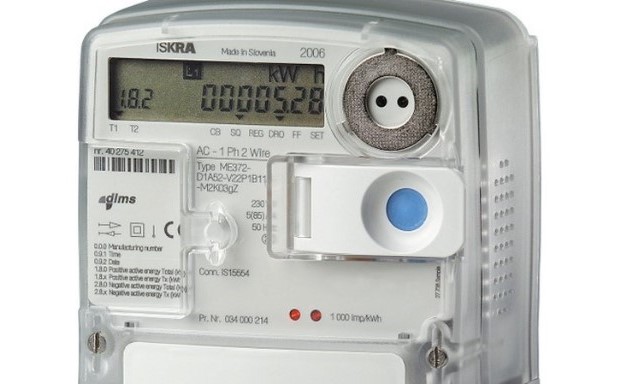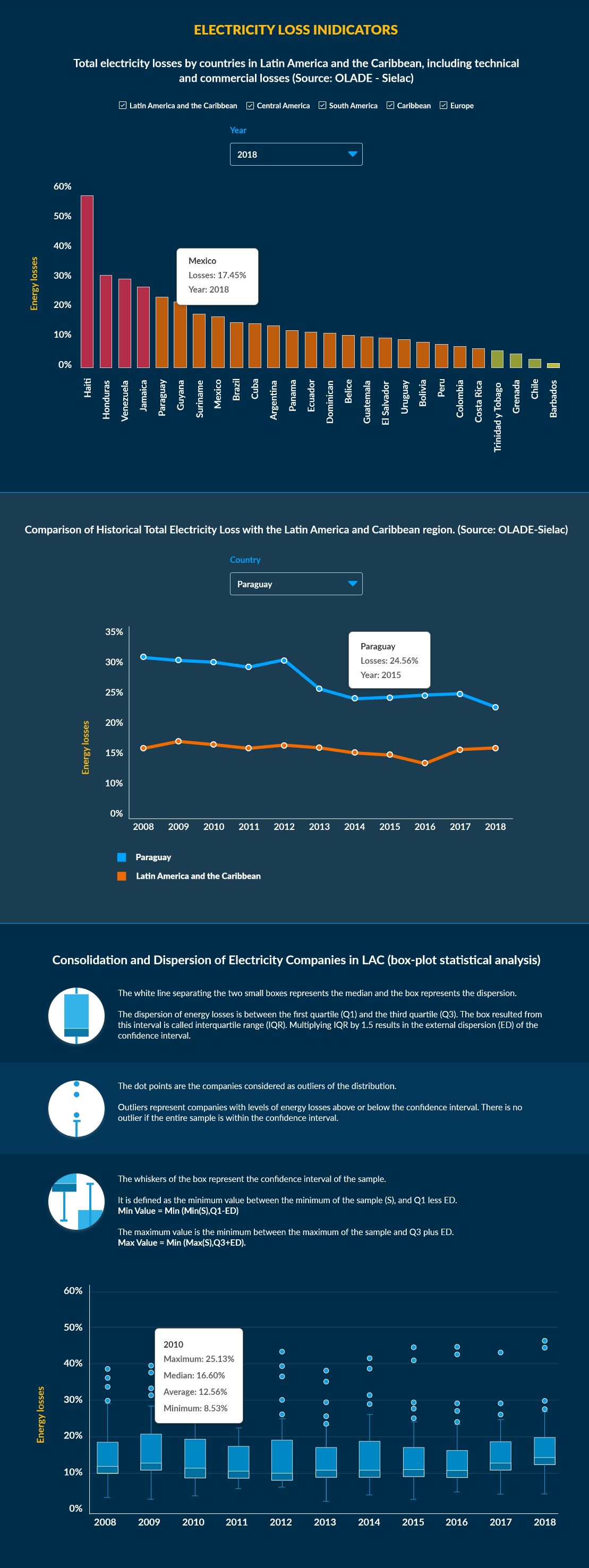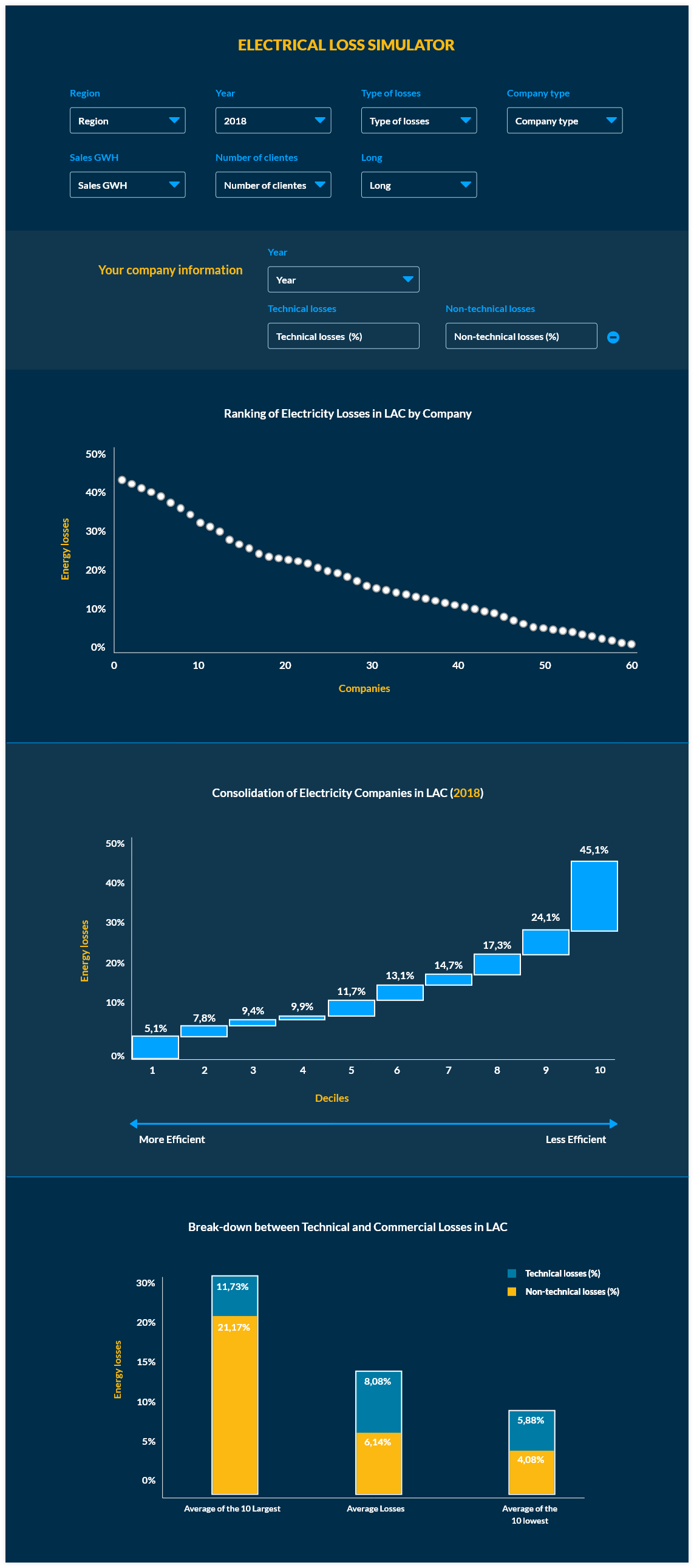Electricity losses in the Latin America and the Caribbean
Electricity losses in the Latin America and the Caribbean is 15% representing large financial losses for the utilities and contributing to lower quality of services to consumers.
Technical and Operations Efficiency in Operation (EO) Electricity Loss Reduction
While there are different definitions of electricity losses, these usually converge to the difference between the amount of electricity that enters the network and the amount that is not paid by consumers. In the case of a utility that it is vertically integrated, the losses represent the difference between its generation injected into the grid and the amount not paid by consumers. For the case of distribution companies, it refers to the power that was purchased by the utility but not paid by the consumers. In a few cases, it may include the electricity billed to consumers but not collected after a reasonable amount of time (usually 180 days). This represents a financial loss in the account receivable as part of the provision for bad debt (or allowance for uncollectable accounts), and thus for the purpose of this toolkit it is considered an accounting or financial loss (dependent on the accounting rules of each country), and not an electricity commercial loss.

Electricity losses can happen in the transmission or distribution activities. There are different ways to calculate electricity losses, and the section on best practices presents some of these.Most of the electricity losses (around 70-80 percent) are related to the distribution end-user activities, as the transmission losses are usually between 20-30 percent of the total. In LAC for example a study estimated that 18% of losses are in transmission while 81% are in distribution3 This ratio however is not constant when compared to other regions. Other studies identified transmission losses in the USA were around 50% of total losses4.
Electricity losses is an important consideration in the LAC region as they represent an estimated financial cost for the electricity industry that ranged from US$11 to US$17 billion in 2012, equivalent to 0.2 to 0.3 percent of the region’s GDP. Total losses in LAC are around 17%, while for example in the USA it is around 5%5 . Estimates from the IDB study indicate that after allowing for a conservative level of technical losses, the percentage of losses translated into 100 TWh lost in 2012, and without substantial reductions in the future, losses can go up to 182 TWh in 2030.
In this context, the reduction in electricity losses brings important financial benefit to the distribution utility but they cannot be an isolated activity. The reduction of losses is usually part of a strategic transformation of the utility with other performance improvement activities as it requires prioritization of investments and allocation of teams. These are described later in the best practice section.
Electricity losses can be divided in two parts:
Technical losses: correspond to all the energy dissipated in the transport of electrical current in conductors, equipment, and connections due to resistance in the distribution network. Technical losses can be further divided into: (i) fixed technical losses (caused by physical inefficiencies such as hysteresis, Eddy Currents losses in the iron core of transformers, and the corona effect in transmission lines) and (ii) variable technical losses (which can happen when power current flows through the lines, cables, and transformers of the network. These are also called load losses, or series losses).
Non-technical losses or commercial losses are those usually associated with the sale of energy supplied to the end user. There is a part of the energy that is produced, transported and supplied; however, it is not invoiced, or it is invoiced but not paid. These losses can be caused by internal or administrative problems (such as errors in measurement, accounting or record keeping) but they are usually associated with the consumer's own illegal intervention, such as thefts, fraud, alteration of meters, or unmetered supply (when the consumer is responsible).
The reduction of losses is a key activity in the transmission and distribution sub-sectors. However, due to the elasticity of demand, the implementation of a loss reduction program can also affect the generation due to the overconsumption. This is due to the electricity “subregistry” corresponding to the energy consumed by the client that does not circulate through the meter, which is actually reduced from the moment a customer is required to pay for its consumption. By promoting the rational, productive, and efficient use of electricity by consumers, it is estimated that after regularization of the customer, approximately 1/3 of the unregistered consumption does not need to be generated.
At the same time, the regularization of electricity services improves the wellbeing of customers as residential consumption of modern energy sources is correlated with per capita income6. The regularization of services also enables the possibility of using electricity for productive activities and further economic development.
Based on available methodologies and definitions, it is possible to calculate the indicators of electricity losses by country, utility, and further segmentation by geography based on the availability of data. Whenever possible these indicators must consider the distributional impact of the losses, in particular to those parts of the society which are more vulnerable and have less resources.
Lastly the assessment to develop an electricity loss reduction program needs to acknowledge that the level of effort and activities would be different depending on the level of losses of the utility. For illustration purposes, the following chart7 presents the electricity losses in LAC (technical and non- technical) at country level, which already combines of one or more utilities in a country. For example, Brazil is represented with the average of 17% but the electricity los across the 52 utilities range from 7% to 32%. The wide dispersion at country and regional levels exemplifies that the starting point for each country is different and therefore the activities selected in the toolkit have to be tailored to each country (and utility) situation.
Technical and Operations Efficiency in Operation (EO) Indicators

Data and statistics from the energy sector, including indicators on electricity losses can be found at the
IDB energy hub.
The energy hub is constantly updated with new information.
Technical and Operations Efficiency in Operation (EO) Self Assessment

How much the level of technical and commercial electricity losses in distribution has increased or decreased in the last three years? What has been the trend over the past five to ten years?
How much support the utility has from the national authorities to introduce a comprehensive loss reduction program? Is this program fully articulated with the authorities and does the utility has their commitment towards implementation?
How engaged is the utility with law enforcement authorities such as local police on matters of electricity theft? Is this collaboration clearly understood by everyone and described in a transparent manner?
Does the regulatory framework contemplate proper incentives to reduce electricity losses? How is the tariff calculation impacted by electricity losses?

Does the utility have a baseline study calculating the technical and non-technical electricity losses, and a roadmap establishing the priority activities to reduce losses in a comprehensive plan? How updated is this baseline plan?
Does the utility have a unit dedicated to reducing electricity losses? What is the government and authority level of this unit?
Does the utility have a commercial system that is well managed with control mechanisms, and proper governance with clearly defined user access rules?
Has the utility developed an infrastructure investment plan and identified financing options to implement the loss reduction program?

Has the utility engaged the relevant communities identifying affordability considerations and facilitating access to credit and ability to pay?
Has the utility established a training program with contracted crews and partnerships with inspection companies with incentives to reduce electricity loss?
Data and statistics from the energy sector, including indicators on electricity losses can be found at
the
IDB energy hub.
The energy hub is constantly updated with new information.
Technical and Operations Efficiency in Operation (EO) Electricity Loss Reduction
This toll facilitates comparing the performance of an individual utility with the database of utilities in the Latin America and Caribbean region. The users can enter their individual performance on the indicator and the chart will display its performance against the database.

Technical and Operations Efficiency in Operation (EO) Electricity Loss Reduction
International experience in the management and reduction of electricity losses indicates that a company must have a “holistic view” of this activity since it integrates several units, and the results have a large impact on its financial and operational results. The LAC region has implemented successful electricity loss programs, and these are illustrated in the next section of references. Considering the indicators calculated for this company compared to external references, and the good practices described below, it is possible to establish an action plan with the activities to reduce electricity losses.
For each practice, the main “insights” found in companies that have been successful in this field are listed. These insights are not authoritative, since each company must adapt the practices to its reality, however they serve as general guidelines to assist the company to advance its respective good practice.
The practices of electricity losses are organized in 10 items across three main groups which are presented next: (i) public actions and State leadership; (ii) operations, commercial, and financial practices part of a distributing company (core part of the activities of a distribution utility), and (iii) social and equity considerations.
International best practices indicate national authorities and policy makers can make important contributions to a successful International best practices indicate national authorities and policy makers can make important contributions to a successful
The operational, commercial and financial best practices refer to the core activities of an electricity utility. This grouping
Obtain political support with government authorities and promote awareness for the introduction of a program.
Promote awareness and establish partnerships with local control authorities such as local police and law enforcement.
Take into consideration regulatory aspects. Utilities can engage the regulatory authority to ensure the proper incentive mechanisms.
Establish unit dedicated to losses within the utility. Most programs are accompanied by an activity to strengthen the.
Establish unit dedicated to losses within the utility. Most programs are accompanied by an activity to strengthen the.
Prioritize investments in technology and smart metering technologies. Investments made to deploy technology tools such as.
Strengthen access to and functionality of the commercial systems. Experience has shown the importance of making regular.
Establish a dedicated infrastructure investment plan in the distribution network and secure resources to reduce vulnerability.
Social participation as part of a soft initiative with the impacted communities, their leaderships and population, with analysis.
Establish a training program and management of the contracted crews to observe their ethical behavior with.
Data and statistics from the energy sector, including indicators on electricity losses can be found at the
IDB energy hub.
The energy hub is constantly updated with new information.
Technical and Operations Efficiency in Operation (EO) Electricity Loss Reduction
For more information regarding the financial management and sustainability, please consult the Case Studies:
Social and Equity Considerations
This grouping of social and equity considerations consolidates the best practices in the community engagement